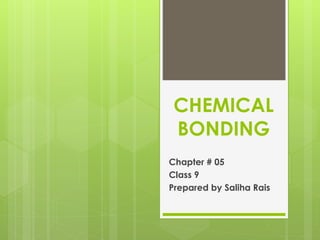
Chemical bonding by Saliha Rais
- 1. CHEMICAL BONDING Chapter # 05 Class 9 Prepared by Saliha Rais
- 2. CHEMICAL BOND The forces which holds atoms together in a molecule or a crystal is called a Chemical Bond
- 3. TYPES OF CHEMICAL BONDS There are two major types of bonds: 1. Ionic or Electrovalent Bond. 2. Covalent Bond.
- 4. IONIC BONDS
- 5. IONIC OR ELECTROVALENT BOND Complete transfer of electron from one atom to another. The atom that transfers electron gets positive charge. The atom that gains electrons gets negative charge. The strong electrostatic force acting between positive and negative ions holds them together.
- 6. DEFINITION “The attraction that binds oppositely charged ions together is termed electrovalent bond, or ionic bond.”
- 7. EXAMPLE Sodium atom transfers one outer most shell electron and become positive sodium ion, and chlorine atom gains that electron to complete its outermost shell(octet) and become chloride negative ion.
- 8. CHARACTERSTICS OF IONIC COMPOUNDS 1. In the crystals of ionic compounds the oppositely charged ions are mutually surrounded by each other in orderly arrangement. Thus ionic compounds are solids at room temperature.
- 9. 2. Ionic compounds have high melting and boiling points because of strong electrovalent bonds existing between the ions.
- 10. 3. Ionic solids do not conduct electricity, as the ions are not free to move. Once an ionic compound is melted (fused) the ions are free to move and conduct electricity. Similarly, Solutions of ionic compounds conduct electricity.
- 11. 4. Ionic compounds are usually soluble in polar solvents, i.e. solvents of high dielectric constant, such as water. But they are insoluble in non-polar, organic solvents. These solvents have low dielectric constant value, such as benzene, carbon tetrachloride, etc. They are mostly inorganic compounds.
- 13. CAN YOU GUESS….! When two same elements combine, does the electrons transfer? When two different elements having same electronegativity reacts, does the electron transfer occur?
- 14. When two or more atoms of the same element, or atoms of different elements having same electronegativity react, the transfer of electron does not occur.
- 15. The atoms complete there outermost shells by sharing unpaired electrons, and a covalent bond is formed. In covalent bond each atom has to contribute equal number of unpaired electrons.
- 16. DEFINITION “The shared pair of electrons which links the atoms in a molecule is known as covalent bond.”
- 17. The bond is expressed by a single short line.
- 18. TYPES OF COVALENT BONDS There are three types of covalent bond. 1. Single covalent bond 2. Double covalent bond 3. Triple covalent bond.
- 19. 1. SINGLE COVALENT BOND: Only one pair of electrons is shared by the boned atoms. Each atom has to share one electron. It is represented by single short line (----)
- 20. 2. DOUBLE COVALENT BOND: Two pairs of electrons are shared by the bonded atoms. Each atom has to share two unpaired electrons. It is represented by two short lines.
- 21. 3. TRIPLE COVALENT BOND: Three pairs of electrons are shared between the bonded atoms. Each atom has to share 3 unbounded electrons. It is denoted by three short lines.
- 22. CHARACTERSTICS OF COVALENT COMPOUNDS. 1. Compounds with covalent bonds are usually made up of discrete units with a weak intermolecular force.
- 23. 2. In the solid state there are weak Vander Wall forces between the molecules. Hence covalent compounds are often gases, liquids or soft solids with low melting points.
- 24. 3. They are insulators because they do not conduct electricity. 4. Covalent compounds are usually insoluble in polar solvents like water, but soluble in organic solvents like benzene, ether, etc.
- 25. ELECTRONEGATIVITY IN COVALENT COMPOUNDS. If a covalent bond is formed between two like atoms, the molecule is called non-polar, because the electron pair is shared equally between two same atoms.
- 26. However if the covalent bon is formed between two dissimilar atoms, the attraction for electron pair would not be equal. One atom will attract the shared pair more towards itself.
- 27. ELECTRONEGATIVITY “The power of an atom to attract the shared pair of electrons towards itself, is known as electronegativity.”
- 28. IONIC CHARACTER IN COVALENT BOND: 1. NON-POLAR COVALENT BONDS 2. POLAR COVALENT BONDS 3. ELECTROVALENT BONDS
- 29. 1. NON-POLAR COVALENT BONDS It is the covalent bond between two like atoms The molecule will be electrically neutral as well as symmetrical. The difference in the electronegativities of the bonded atoms will be zero.
- 30. 2. POLAR COVALENT BONDS: It is the covalent bond formed between two dissimilar atoms. The shared pair of electron will move closer to more electronegative atom. There will be partial positive and partial negative charges on the atoms. The difference of electronegativities is up to 1.7. These molecules are partially ionic in character.
- 31. 3. ELECTROVALENT BONDS: When the difference in the electronegativities of bonded atoms is more than 1.7, than the bond is purely ionic or electrovalent. The participating atoms will bear a + or – charge.